by Bruce Wells | Aug 11, 2025 | This Week in Petroleum History
August 11, 1891 – Pole Cat Well brings Prosperity to Sistersville –
The discovery well of the Sistersville oilfield brought great wealth to a small West Virginian town on the Ohio River north of Parkersburg and Burning Springs (see Confederates attack Oilfield). “The bringing in of the ‘Pole Cat’ well, which pumped water for a year before it pumped oil, brought in a sudden influx of oil men, drillers, leasers, speculators, followers, floaters, wildcatters, and hangers-on,” a local historian noted.
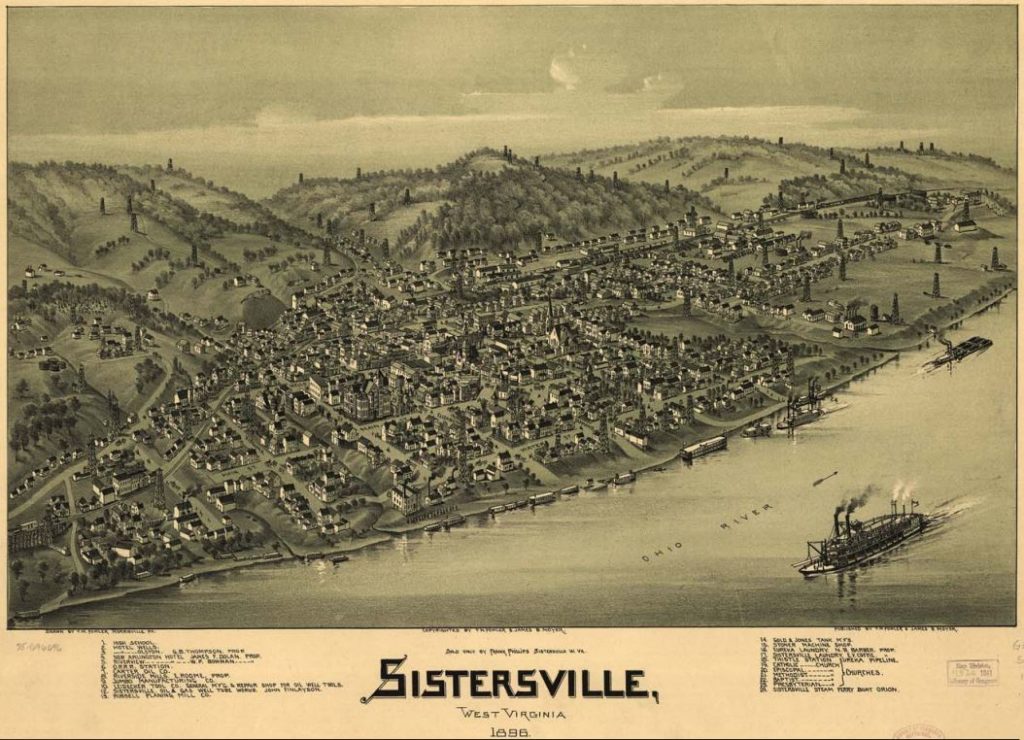
Bird’s-eye-view artist Thaddeus M. Fowler created maps of prospering towns and cities during the Industrial Revolution, including many oil boom towns like his 1896 lithograph of Sistersville, West Virginia. Map courtesy Library of Congress.
The petroleum wealth changed Sistersville from a rural village of 300 people “to a rip-roaring” metropolis of 15,000 people almost overnight. At the height of its petroleum prosperity, cartographic artist Thaddeus M. Fowler of Massachusetts illustrated Sistersville in one of his popular “bird’s eye” maps (see Oil Town “Aero Views”).

2025 West Virginia Oil & Gas Festival Queen Haley Spencer receives her crown from Mia Grace Bailey. Photo courtesy Tyler Star News.
On September 11, 2025, Tyler County’s Ohio River community will host its three-day celebration of the 1891 Pole Cat well (later renamed the Sistersville well). Events at Sistersville City Park will include the Gib Morgan Wrench Throwing Contest and other oilfield-related events hosted by 57th West Virginia Oil and Gas Festival Queen Haley Spencer, crowned in July at the Tyler Consolidated High School Auditorium.
August 11, 1998 – Amoco announces BP merger
Amoco announced plans to merge with London-based British Petroleum Company in a stock swap valued at about $48 billion — then the world’s largest industrial merger. Amoco began in 1889 as John D. Rockefeller’s Standard Oil Company of Indiana. The company officially changed its name to Amoco in 1985.
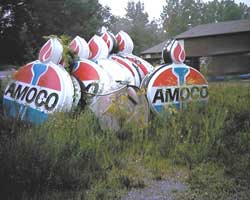
BP closed all of its Amoco stations in 2001.
Finalized on December 31, the combined company, BP Amoco PLC, became 60 percent owned by BP shareholders, marking the transaction as the largest foreign takeover of an American company. Originally named the Anglo-Persian Oil Company in 1935, British Petroleum in 2000 rebranded into BP and announced the closure or renaming of its Amoco stations.
August 12, 1888 – World’s First Auto Road Trip
Thirty-nine-year-old Bertha Benz made history when she became the first person to make a long-distance trip by automobile. Her adventure also included “the first road repairs, the first automotive marketing stunt, the first case of a wife borrowing her husband’s car without asking, and the first violation of intercity highway laws in a motor vehicle,” proclaimed a 2018 article in Wired.
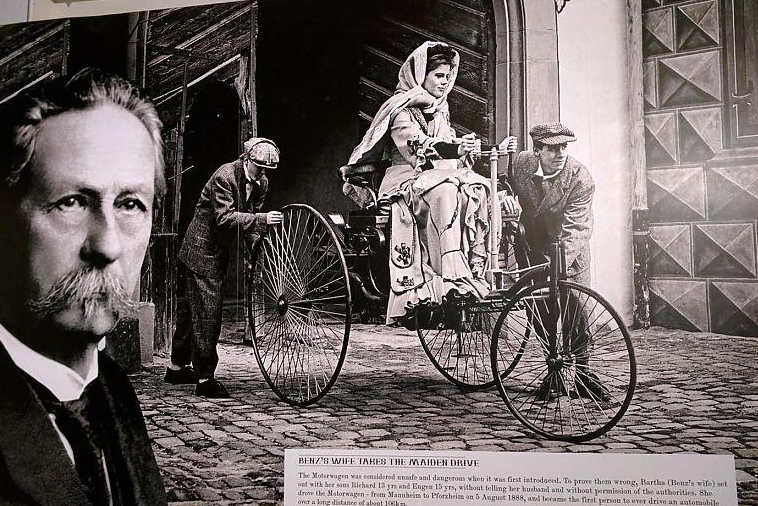
Bertha Benz became the world’s first female automotive pioneer in 1888. Image courtesy Mercedes-Benz Museum.
Bertha drove away in the “Patent Motorwagen” (after leaving a note to her husband) and took their two sons, Eugen, 15, and Richard, 13, to visit her mother in Pforzheim, according to Wired. The trip from Mannheim covered about about 60 miles. “She knew she’d need help, because the 0.88-horsepower engine was a little underpowered, to say the least, and would need to be pushed up some of the steeper hills.”
The 15-hour drive — today the Bertha Benz Memorial Route — helped popularize Karl Benz’s invention. By the end of the century, Mercedes-Benz was the largest car company in the world. The Automotive Hall of Fame inducted Bertha as the first female automotive pioneer in 2016.
Learn more in First Car, First Road Trip.
August 12, 1930 – Kentucky Oil and Gas Producers unite
Eastern Kentucky independent producers joined the Western Kentucky Oil Men’s Association to create a state-wide organization in Frankfort — today’s Kentucky Oil and Gas Association (KOGA). A 1919 oil discovery in Hancock County had launched the petroleum industry in western Kentucky, where commercial amounts of oil had been found as early as 1829 near Burkesville while drilling for brine with a spring-pole (also see Kentucky’s Great American Well).
August 13, 1962 – Norman Rockwell illustrates Oil and Gas Journal
The Oil and Gas Journal promoted itself with an illustration from artist Norman Rockwell in an ad captioned, “Where Oil Men Invest Their Valuable Reading Time.” Rockwell’s renditions of American life brought him popularity through magazines like the Saturday Evening Post, Boy’s Life, and Leslie’s Illustrated Weekly.
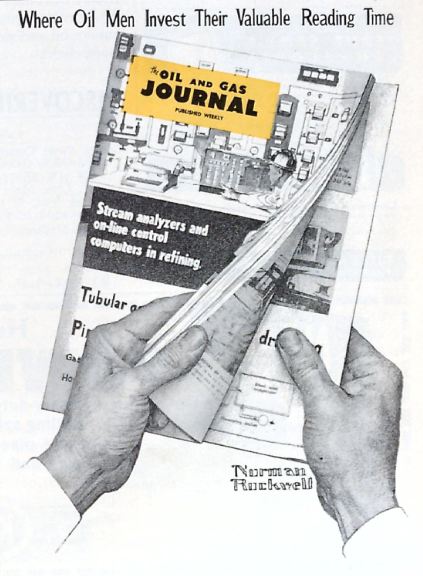
A Norman Rockwell illustration advertised the Oil and Gas Journal, a weekly trade magazine, “Where Oil Men Invest Their Valuable Reading Time.”
In addition to the illustrations for the Oil and Gas Journal, Rockwell in 1959 provided artwork to the American Petroleum Institute (API), which sponsored a U.S. Postal Service “first day of issue” commemorating the 1959 centennial of the birth of the U.S. oil industry (see Centennial Oil Stamp Issue).
The illustration included the slogan “Oil’s First Century 1859-1959, Born in Freedom Working for Progress.”
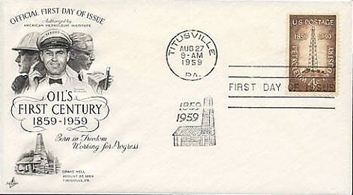
Norman Rockwell’s art commemorated the 1959 centennial of the birth of the nation’s oil industry.
Rockwell’s drawing depicted “the men of science, the rugged extraction of the crude oil, and ending with your friendly service station attendant,” according to a collector.
August 14, 1986 – California Oil Museum Building listed as National Historic Place
The original headquarters of the Union Oil Company in Santa Paula, California — constructed in 1890 and an oil museum since 1950 — was added to the National Register of Historic Places. Today, the California Oil Museum on 1001 East Main Street includes renovated Union Oil offices on the second floor, above the former Santa Paula Hardware Company and Post Office. Union Oil moved its headquarters to Los Angeles in 1901.
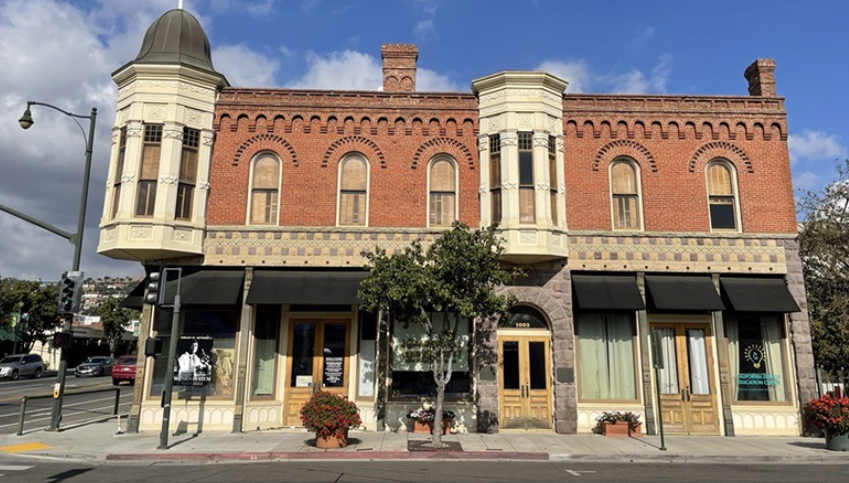
The headquarters of the Union Oil Company of California, founded in Santa Paula in 1890, occupied the second floor; a hardware store and post office were located on the first floor. Chevron donated the building to the city in 2024. Photo courtesy Chevron.
Also designated a Ventura County Cultural Heritage Landmark, the California Oil Museum exhibits working oilfield models, a 19th-century cable-tool drilling rig, Union Oil gas station memorabilia, and an Energy Education Lab with STEM activities for students.

August 15, 1945 – End of World War II Gas Rationing
One day after President Harry Truman announced World War II was over, gasoline rationing ended in America. Food rationing had begun in early 1942 with rubber and gasoline added in December by the Office of Price Administration. Most civilian drivers received a windshield sticker with ration coupons for gasoline, limiting purchases to four gallons a week. A ration book “B” sticker allowed business owners up to eight gallons a week.
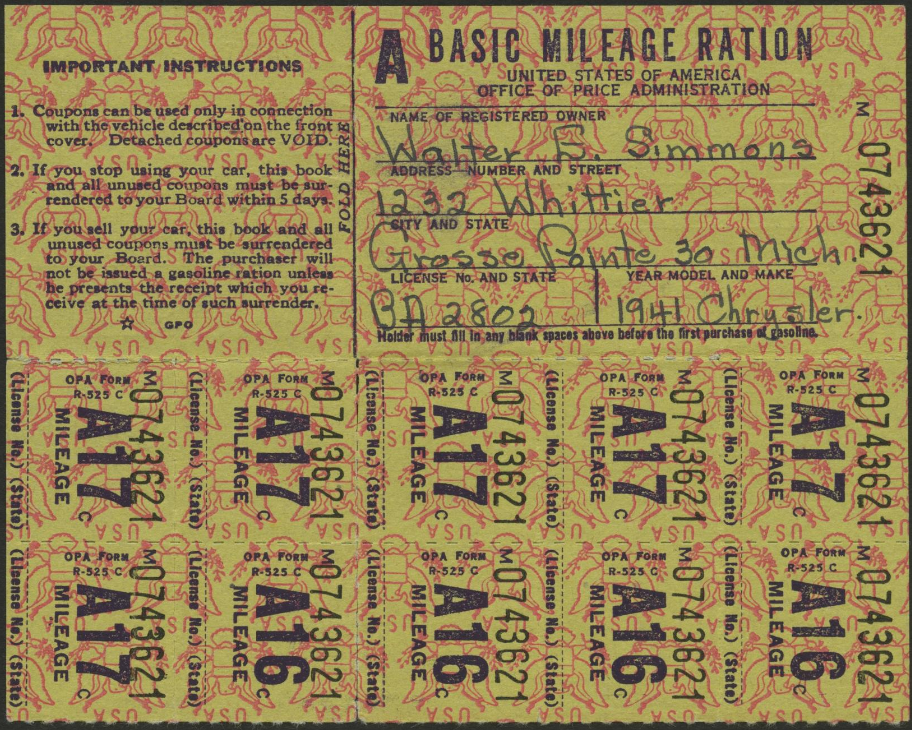
World War II gasoline ration stamps and mileage card, Grosse Pointe, Michigan, courtesy Henry Ford Museum.
According to the National World War Two Museum, a “C” sticker was for people with professional occupations, an “M” sticker for motorcycles, and a “T” sticker for truck drivers. A 35 mph speed limit was established for the duration of the war. By the end of 1945, sugar remained the only commodity still being rationed.
August 16, 1861 – World’s Oldest Producing Well
What would become the oldest continuously producing oil well was completed near Oil Creek at Oil City, Pennsylvania. The McClintock No. 1 well initially produced 50 barrels of oil a day from a depth of 620 feet. The well, completed 14 miles from the first U.S. oil discovery two years earlier, has produced continuously at its original depth, according to the Oil Region Alliance.
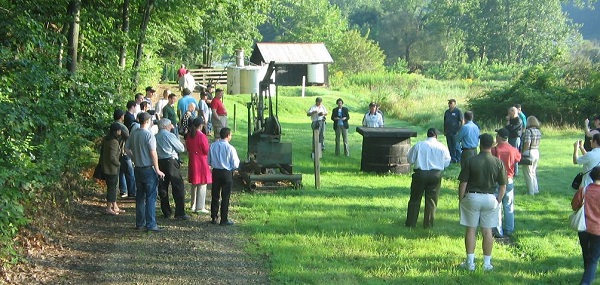
A “Rock Oil Tour” of energy economists from Washington D.C, in 2009 included a stop at the 1861 McClintock well, today pumped a few times a year to supply souvenir bottles sold at the Drake Well Museum in Titusville, Pennsylvania. Photo by Bruce Wells.
Donated by Quaker State in 1995 after the company announced the move of its headquarters from Oil City to Dallas, the McClintock well has pumped monthly to produce up to 10 barrels of oil. Souvenir bottles of the oil today are sold in the Titusville gift shop of the Drake Well Museum.
A historic marker on Route 8 south of Rouseville identifies the record-setting McClintock well, but thousands pass by each year without knowing it’s there. Across the railroad, about 240 yards away, another historic marker commemorates an early oilfield tragedy — the Rouseville 1861 oil well fire.

August 16, 1927 – High-Octane Gas powers Air Race to Hawaii
With a crowd of 50,000 cheering them on, eight monoplanes took off from an airfield in Oakland, California, in an air race over the Pacific. Dole Pineapple Company offered a $25,000 prize to the first plane to reach Honolulu, 2,400 miles away. Three months earlier, Charles Lindbergh had made the first solo trans-Atlantic flight of 1,500 miles.

Several competitors disappeared over the Pacific during the 1927 Dole air race. The winning aircraft today is on display at the Woolaroc Ranch near Bartlesville, Oklahoma.
A new aviation fuel developed by Phillips Petroleum — Nu-Aviation Gasoline — powered the winning “Woolaroc” monoplane for the deadly air race (two of the fuel-heavy planes crashed on takeoff, others were lost in flight). Woolaroc was named for Frank Phillips’ Bartlesville ranch and nature preserve.
Learn more in Flight of the Woolaroc.
August 17, 1785 – “Bituminous Matter” reported at Oil Creek
Two years after the end of the Revolutionary War, oil was reported floating on a creek in northwestern Pennsylvania. “Oil Creek has taken its name from an oil or bituminous matter being found floating on its surface,” noted a report by Gen. William Irvine. “Many cures are attributed to this oil by the natives, and lately by some of the whites, particularly rheumatic pains and old ulcers,” Gen. Irvine wrote.
The discovery confirmed an earlier Army survey reporting that Oil Creek “empties itself into the Allegheny River, issuing from a spring, on the top of which floats an oil, similar to what is called Barbados Tar (see Asphalt Paves the Way), and from which may be collected by one man several gallons in a day.” Decades later, George Bissell studied the seeps, which led to drilling of the first U.S. oil well there in 1859.

August 17, 1915 – End of Hand-Cranked Engines
Charles Kettering of Dayton, Ohio, patented an “engine-starting device,” the first practical electric starter for automobiles. Working as an engineer for Dayton Engineering Laboratories Company (DELCO), Kettering had earlier devised an electric motor to replace hand cranks on cash registers. “The present invention is particularly applicable to automobiles, wherein an engine of the combustion or explosion type is employed, as a means of propulsion,” Kettering noted in his patent.
In addition to his engine-starting patent, in 1921 Kettering and fellow General Motors chemist Thomas Midgley Jr. discovered the gasoline additive tetraethyl lead (see Ethyl Anti-Knock Gas). Cadillac was the first manufacturer to add electric starters to its models. The Ford Model T used a hand crank until 1919; replacing the dangerous method proved popular, especially among women drivers.
_______________________
Recommended Reading: Where it All Began: The story of the people and places where the oil & gas industry began: West Virginia and southeastern Ohio (1994); Bird’s Eye Views: Historic Lithographs of North American Cities
(1994); Bird’s Eye Views: Historic Lithographs of North American Cities (1998); Bertha Takes a Drive: How the Benz Automobile Changed the World
(1998); Bertha Takes a Drive: How the Benz Automobile Changed the World (2017); Western Pennsylvania’s Oil Heritage
(2017); Western Pennsylvania’s Oil Heritage (2008); Winners’ Viewpoints: The Great 1927 Trans-Pacific Dole Race
(2008); Winners’ Viewpoints: The Great 1927 Trans-Pacific Dole Race (2009); Groundbreakers: The Story of Oilfield Technology and the People Who Made it Happen (2015); Sign of the 76: The fabulous life and times of the Union Oil Company of California
(2009); Groundbreakers: The Story of Oilfield Technology and the People Who Made it Happen (2015); Sign of the 76: The fabulous life and times of the Union Oil Company of California (1977); Trek of the Oil Finders: A History of Exploration for Petroleum (1975); Unleaded: How Changing Our Gasoline Changed Everything (2021). Your Amazon purchase benefits the American Oil & Gas Historical Society. As an Amazon Associate, AOGHS earns a commission from qualifying purchases.
(1977); Trek of the Oil Finders: A History of Exploration for Petroleum (1975); Unleaded: How Changing Our Gasoline Changed Everything (2021). Your Amazon purchase benefits the American Oil & Gas Historical Society. As an Amazon Associate, AOGHS earns a commission from qualifying purchases.
_______________________
The American Oil & Gas Historical Society (AOGHS) preserves U.S. petroleum history. Please become an AOGHS annual supporter and help maintain this energy education website and expand historical research. For more information, contact bawells@aoghs.org. © 2025 Bruce A. Wells. All rights reserved.
by Bruce Wells | Aug 4, 2025 | This Week in Petroleum History
August 4, 1913 – Discovery of Oklahoma’s “Poor Man’s Field” –
The Crystal Oil Company completed its Wirt Franklin No. 1 well 20 miles northwest of Ardmore, Oklahoma. The wildcat well revealed the giant Healdton field, which became known as “the poor man’s field” because of its shallow depth and low cost of drilling. The area attracted many independent producers with limited financial backing.
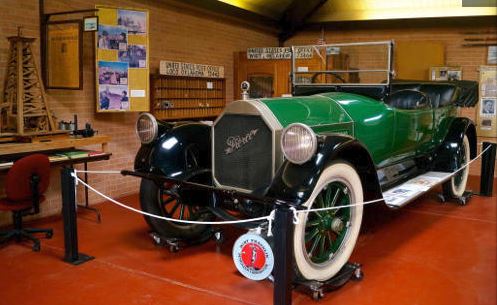
Healdton Oil Museum exhibits include the 1920 Pierce-Arrow owned by Wirt Franklin, who in 1929 founded a national trade association of independent oil and natural gas producers.
Another oil discovery in 1919 revealed the Hewitt field, which extended production 22 miles across Carter County. The Greater Healdton-Hewitt oilfield produced “an astounding 320,753,000 barrels of crude by the close of the first half of the 20th century,” noted Kenny Franks in his 1989 book, Ragtown: A History of the Greater Healdton-Hewitt Oil Field.
A young Erle P. Halliburton perfected a new method of cementing oil wells in “the poor man’s field” (see Halliburton and the Healdton Oilfield). Wirt Franklin of Ardmore became the first president of the then Tulsa-based Independent Petroleum Association of America (IPAA) in 1929.
August 4, 1977 – U.S. Department of Energy established
President Jimmy Carter signed the Department of Energy Organization Act, establishing the twelfth cabinet-level department by consolidating a dozen federal agencies and energy programs. The Act combined the Federal Energy Administration and the Energy Research and Development Administration, making the new Department of Energy (DOE) responsible for nuclear weapon programs and national labs. James Schlesinger was sworn in as the first Secretary of Energy.

August 5, 1882 – Rockefeller founds Standard Oil of New Jersey
Twelve years after launching Standard Oil Company of Ohio (bp America), John D. Rockefeller founded the Standard Oil Company of New Jersey (ExxonMobil) as a refining and marketing arm of the Standard Oil Trust, which would reorganize as Standard Oil Interests in 1892, two years after the Sherman Anti-Trust Act.
“Taking advantage of New Jersey laws that allowed corporations to own stock in other corporations, Standard Oil Company of New Jersey became a holding company that effectively replaced the Standard Oil Trust. In this capacity, it provided administrative coordination to Standard Oil Interests and held stock in forty-one other oil companies,” notes the American Heritage Center, University of Wyoming. The U.S. Supreme Court in 1911 ordered Standard Oil of New Jersey to separate from its subsidiaries.
August 7, 1933 – Permian Basin inspires “Alley Oop” Comic Strip
Although the comic strip “Alley Oop” began syndication with the Newspaper Enterprise Association, the caveman character began in Permian Basin oilfields of the 1920s. A small, West Texas oil town would proclaim itself the inspiration for cartoonist Victor Hamlin.
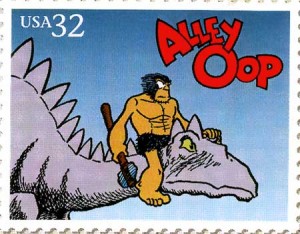
A 1995 stamp commemorated “Alley Oop” by Victor Hamlin, who once worked in oilfields at Yates, Texas.
Iraan (pronounced eye-rah-ann) began as a company town following the October 1926 discovery of the giant Yates oilfield. The town’s name combined the names of Ira and Ann Yates. As petroleum drilling in the Permian Basin boomed, future Alley Oop cartoonist Hamlin worked as an oil company cartographer. He developed a lifelong interest in geology and paleontology that helped inspire his popular Depression Era comic strip.
Learn more in Alley Oop’s Oil Roots.
August 7, 1953 – Outer Continental Shelf Lands Act generates Revenue
The Outer Continental Shelf Lands Act designated the Secretary of the Interior responsible for the administration of mineral exploration and development of America’s outer continental shelf. Forty-four Gulf of Mexico wells were already operating in 11 oilfields by 1949. As the offshore industry evolved in the 1950s, petroleum production became the second-largest revenue generator for the country, after income taxes.
Since 1982, the Interior Department has disbursed more than $387 billion in mineral leasing revenues. The Office of Natural Resources Revenue (ONRR ) in 2024 reported a disbursement of $16.45 billion (down from $18.24 billion in 2023) generated from energy production on federal and Tribal lands and federal offshore areas. Monthly disbursements came from the royalties, rents, and bonuses collected from energy and mineral companies operating on federal lands and waters.
August 7, 2004 – Death of a Famed “Hellfighter”
Famed oilfield well control expert and firefighter Paul “Red” Adair died at age 89 in Houston. The son of a blacksmith, Adair was born in 1915 in Houston. He served with a U.S. Army bomb disposal unit during World War II.

Famed oilfield firefighter Paul “Red” Adair of Houston, Texas, in 1964.
Adair had begun his oilfield career working for Myron Macy Kinley, who patented a technology for using charges of high explosives to snuff out well fires. Kinley, whose father had been an oil well shooter in California in the early 1900s, mentored many other firefighters, including Asger “Boots” Hansen and Edward “Coots” Mathews (Boots & Coots International Well Control).
After founding the Red Adair Company in 1959, Adair developed new techniques as his company extinguished over 2,000 well fires worldwide, onshore and offshore. The oilfield firefighter’s skills, dramatized in the 1968 film “Hellfighters,” were put to the test in 1991, when his company extinguished 117 well fires set in Kuwait by the retreating Iraqi army. Innovative oilfield firefighting technologies began as early as the 1860s.

August 9, 1921 – Reflection Seismography reveals Geological Structure
A team led by University of Oklahoma geophysicist John C. Karcher conducted the world’s first reflection seismograph measurement of a geologic formation, pioneering the use of reflection seismic technology. The geological section measurement followed limited tests in June and July at Oklahoma City. His work led to the discovery of many of the world’s largest oil and natural gas fields.
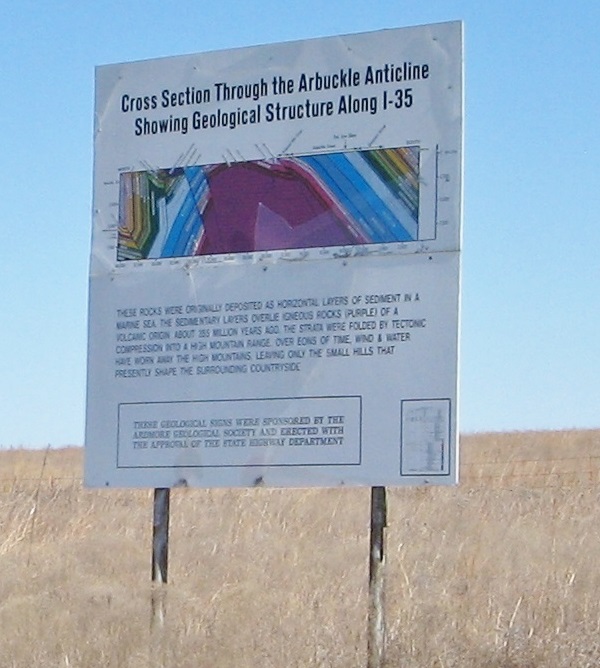
A roadside sign on I-35 south of Oklahoma City includes a geologic illustration of the Arbuckle Anticline. A nearby marker describes how using reflection seismography for oil exploration began here. Photo by Bruce Wells.
The new geophysical method recorded reflected seismic waves as they traveled through the earth, helping to define oil-bearing formations. The Arbuckle Mountains of Oklahoma were selected for testing the technique and new equipment, according to a roadside marker at the site south of Oklahoma City on I-35.
Learn More in Exploring Seismic Waves.
August 9, 1922 – Giant Oilfield revealed in Luling, Texas
After drilling six dry holes near Luling, Texas, the United North & South Oil Company completed its Rafael Rios No. 1 well. Company President Edgar B. Davis remained determined to find oil in the Austin chalk geologic formation. His perseverance paid off with an oilfield 12 miles long and two miles wide. The Luling field annually produced 11 million barrels of oil by 1924.
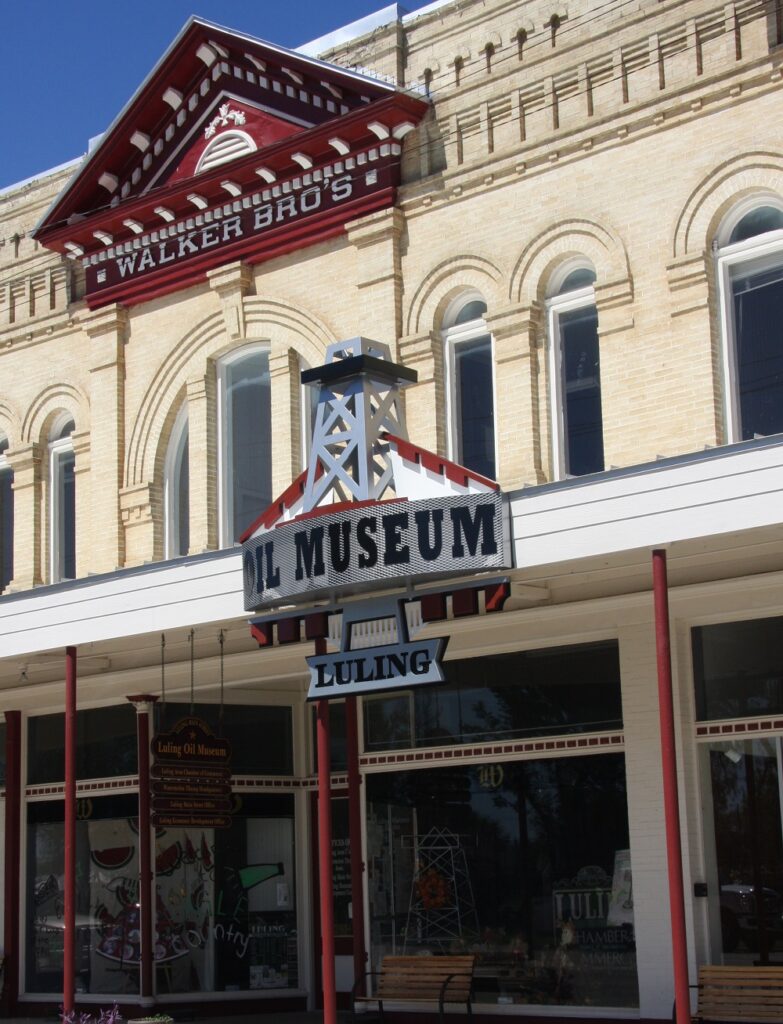
The Luling Oil Museum in central Texas is in a restored 1885 mercantile store near the 1922 oilfield a psychic claimed to help discover. Photo courtesy Luling Oil Museum.
On June 11, 1926, Davis sold his Luling leases to the Magnolia Petroleum Company for $12 million – the largest petroleum deal in Texas at the time. Success also produced local tales of Davis finding the Luling oilfield after consulting a psychic. Self-proclaimed clairvoyant Edgar Cayce reported he had helped Davis, but the psychic formed an exploration company that failed after drilling dry holes.
Learn more in Luling Oil Museum and Crudoleum.
On August 9, 1949 – Oil discovered in Western Nebraska
An oilfield discovery in western Nebraska ended decades of unsuccessful searching and helped start the state’s modern petroleum industry. The Marathon Oil Company Mary Egging No. 1 well, five miles southeast of the town of Gurley, produced 225 barrels of oil per day from a depth of 4,429 feet.
According to a nearby historical marker, the first exploratory well drilled in the area near Harrisburg failed in 1917. The success in western Nebraska came nine years after the first Nebraska oil well was completed in 1940 in the southeastern corner of the state.

Marathon Oil in May 2024 announced it was being acquired by ConocoPhillips in an all-stock transaction valued at $22.5 billion.
August 10, 1909 – Hughes patents Two-Cone Drill Bit
“Fishtail” drill bits became obsolete after Howard Hughes Sr. of Houston, Texas, patented the dual-cone roller bit with two rotating cones. By pulverizing hard rock, his bit led to faster and deeper rotary drilling. A few months before receiving the 1909 drill patent, Hughes and Walter Sharp established the manufacturing company Sharp-Hughes Tool (see Carl Baker and Howard Hughes).
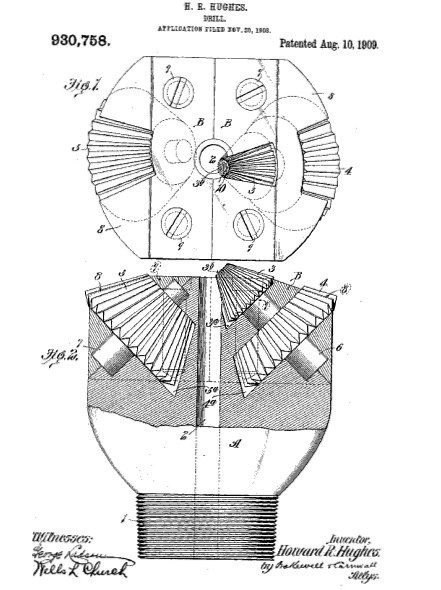
Howard Hughes Sr. of Houston, Texas, received a 1909 patent for “roller drills such as are used for drilling holes in earth and rock.”
“Instead of scraping the rock, as does the fishtail bit, the Hughes bit, with its two conical cutters, took a different engineering approach,” reported the American Society of Mechanical Engineers (ASME). “By chipping, crushing, and powdering hard rock formations, the Hughes Two-Cone Drill Bit could reach vast amounts of oil in reservoirs thousands of feet below the surface. This new drilling technology would revolutionize the industry.”
In 1933, Hughes engineers invented the modern tri-cone bit; Frank and George Christensen developed the earliest diamond bit in 1941; and tungsten-carbide bits arrived in the early 1950s. By the 1970s, synthetic diamonds evolved into the polycrystalline diamond compact bit. ASME in 2009 designated the Hughes two-cone drill bit a Historic Mechanical Engineering Landmark (no. 246).
Learn more in Making Hole – Drilling Technology.
_______________________
Recommended Reading: Ragtown: A History of the Greater Healdton-Hewitt Oil Field (1989); The New Map: Energy, Climate, and the Clash of Nations (1999); Titan: The Life of John D. Rockefeller, Sr.
(1989); The New Map: Energy, Climate, and the Clash of Nations (1999); Titan: The Life of John D. Rockefeller, Sr. (2004); Yates: A family, A Company, and Some Cornfield Geology
(2004); Yates: A family, A Company, and Some Cornfield Geology (2000); An American Hero: The Red Adair Story
(2000); An American Hero: The Red Adair Story (1990); Oil And Gas In Oklahoma: Petroleum Geology In Oklahoma
(1990); Oil And Gas In Oklahoma: Petroleum Geology In Oklahoma (2013); Texas Art and a Wildcatter’s Dream: Edgar B. Davis and the San Antonio Art League
(2013); Texas Art and a Wildcatter’s Dream: Edgar B. Davis and the San Antonio Art League (1998); Drilling Technology in Nontechnical Language
(1998); Drilling Technology in Nontechnical Language (2012). Your Amazon purchase benefits the American Oil & Gas Historical Society. As an Amazon Associate, AOGHS earns a commission from qualifying purchases.
(2012). Your Amazon purchase benefits the American Oil & Gas Historical Society. As an Amazon Associate, AOGHS earns a commission from qualifying purchases.
_______________________
The American Oil & Gas Historical Society (AOGHS) preserves U.S. petroleum history. Please become an annual AOGHS supporter and help maintain this energy education website and expand historical research. For more information, contact bawells@aoghs.org. © 2025 Bruce A. Wells. All rights reserved.
by Bruce Wells | Jul 28, 2025 | This Week in Petroleum History
July 28, 1924 – Oil Scouts form National Group –
The National Oil Scouts Association of America, later the International Oil Scouts Association (IOSA), filed its charter in Austin, Texas, bringing new standards to an important oilfield profession. Since the 1860s, oilfield scouts have gathered field intelligence on drilling operations, including often sensitive information about the operator, well location and lease details — anything that may yield a competitive advantage. These “night riders of the hemlocks” also sleuth drilling depths, geologic formations encountered, logs, and other data.
Learn more in Oil Scouts – Oil Patch Detectives.
July 28, 1953 – Final Oilfield Patent for Zero Hour Bomb Company
Manufacturer of oilfield products since 1932, the Zero Hour Bomb Company of Tulsa, Oklahoma, received its last U.S. patent relating to electric timer explosives for fracturing geologic formations. The service company patented its device for positioning blasting cartridges in wells — a “well bridge” that automatically opened, “when the time bomb or weight reached a position at the bottom of the well.”
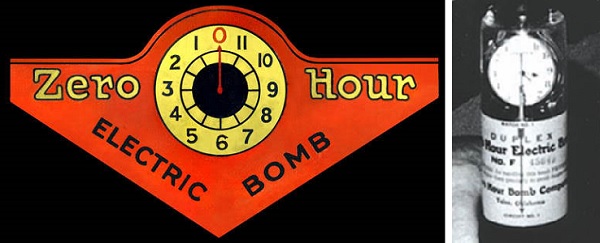
Oilfield service provider Zero Hour Bomb Company was founded in Tulsa, Oklahoma, in 1932. Photos courtesy Zebco.
The downhole apparatus was never built, because company executives already were manufacturing and marketing a new, “cannot backlash” fishing reel invented by Jasper “R.D.” Hull, who they had hired in 1947. Zero Hour Bomb Company changed its name to Zebco in 1956.
Learn more in Zebco Reel Oilfield History.
July 28, 1977 – Trans-Alaska Pipeline delivers Oil to Port of Valdez
The first barrel of oil from the North Slope’s Prudhoe Bay oilfield arrived at the Port of Valdez after an 800-mile journey through the Trans-Alaska Pipeline System.

The Trans-Alaska Pipeline delivered North Slope oil almost a decade after the Prudhoe Bay field’s discovery. OMAR refers to the Organization for Management of Alaska’s Resources, now the Resource Development Council for Alaska.
At peak flow in 1988, 11 pumping stations moved 2.1 million barrels of oil a day. The 48-inch-wide pipeline has been recognized as a landmark of engineering (see Trans-Alaska Pipeline History).
July 29, 1918 – “World’s Wonder Oil Pool” discovered in Texas
Less than a year after the “Roaring Ranger” discovered an oilfield to the south, the Fowler No. 1 well at the cotton farming community of Burkburnett, Texas, revealed a new giant field at a depth of 1,734 feet. Within three weeks, 56 rigs were drilling near the Fowler Farm Oil Company site along the Red River in North Texas.
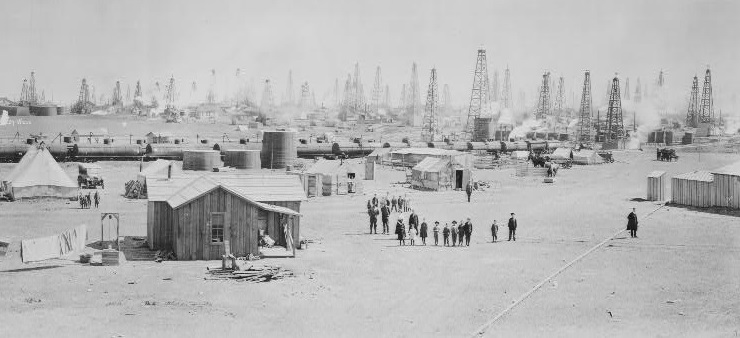
Circa 1919 photo captioned, “Burkburnett, Texas, the World’s Wonder Oil Pool,” showing eight months’ phenomenal development, viewed from the northwest side, opposite Fowler farm.” A. Newman Photographic Company photo courtesy Library of Congress.
Fowler’s decision to drill a well on his Wichita County farm had been called “Fowler’s Folly” until his oil discovery brought hundreds of oil companies to the county. By January 1919, Burkburnett’s population reached more than 8,000 people — with a line of derricks two miles long greeting new arrivals.
As the “World’s Wonder Oil Pool” made national headlines, teenager Clark Gable was a 17-year-old roustabout working in Oklahoma. Gable and Spencer Tracy would star in Hollywood’s version of Burkburnett oil history, the popular 1940 movie “Boom Town.”
Learn more in Boom Town Burkburnett.

July 29, 1957 – Eisenhower limits Oil Imports
As America’s reliance on foreign oil continued to grow — discouraging domestic production — President Dwight D. Eisenhower established a Voluntary Oil Import Program with import quotas by region. The intent was to ensure adequate domestic petroleum in case of a national emergency.
Using a presidential proclamation two years later, Eisenhower made the program mandatory. By 1962, oil imports were limited to 12.2 percent of U.S. production. The program continued until suspended by President Richard Nixon in 1973 as domestic oil production reached new highs during the OPEC oil embargo.
July 30, 1942 – U-166 sinks, discovered 60 years later
A Navy patrol boat attacked and sank a German U-boat in the Gulf of Mexico after the submarine had torpedoed a U.S. freighter. Despite being depth-charged, the U-166 was believed to have escaped — until a natural gas pipeline survey revealed it 59 years later.
The U-166’s identity was not learned until advanced geophysical survey technologies arrived in 2001, according to the National Oceanic and Atmospheric Administration (NOAA). The discovery resulted from an archaeological survey prior to construction of a natural gas pipeline by the British company BP and Shell Offshore Inc.
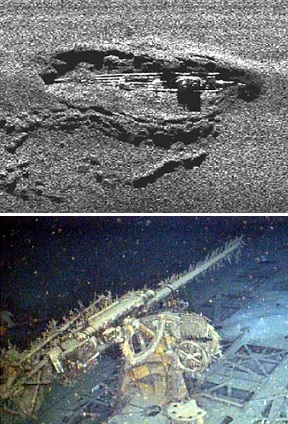
A natural gas pipeline survey revealed the U-166 about 45 miles off the Louisiana coast in 2011.
Remotely operating vehicles (ROVs) and an autonomous side-scan sonar revealed U-166 separated from its last victim, the Robert E. Lee, by less than a mile. BP and Shell altered their proposed pipeline to preserve the site.
With the petroleum industry the principal user of advanced underwater technologies for seafloor mapping, other World War II vessels have been discovered during oil and natural gas surveys.
Learn more in Petroleum Survey discovers U-boat.

August 1, 1872 – Iron Pipeline delivers Pennsylvania Natural Gas
The first large-scale delivery of natural gas by pipeline began when gas was piped to more than 250 residential and commercial customers in Titusville, Pennsylvania, home of America’s first oil well, drilled in 1859. An iron pipeline two inches wide carried the natural gas five miles from a well producing four million cubic feet of gas a day.
Investors, including the mayor of Titusville, had formed the Keystone Gas & Water Company to construct the pipeline and deliver “the most powerful and voluminous gas well on record.” The well produced into the 1880s, according to the Drake Well Museum and Park.
August 2, 1956 – Missouri builds First U.S. Interstate Highway
Missouri became the first state to award a contract with interstate construction funding authorized two months earlier by the Federal-Aid Highway Act. The highway commission agreed to begin work on part of Route 66, now Interstate 44.
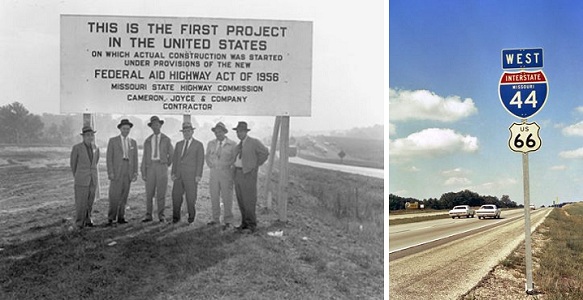
Missouri launched the U.S. interstate system after “inking a deal for work on U.S. Route 66.” Today, I-44 stretches across south central Missouri and is a major corridor linking the Midwest and the West Coast.
“There is no question that the creation of the interstate highway system has been the most significant development in the history of transportation in the United States,” proclaimed the Missouri Department of Transportation (also see America on the Move).
August 3, 1769 – La Brea Asphalt Pits discovered
A Spanish expedition discovered what would be called La Brea (the tar) pits on the West Coast. “We debated whether this substance, which flows melted from underneath the earth, could occasion so many earthquakes,” noted the expedition’s Franciscan friar in his diary.
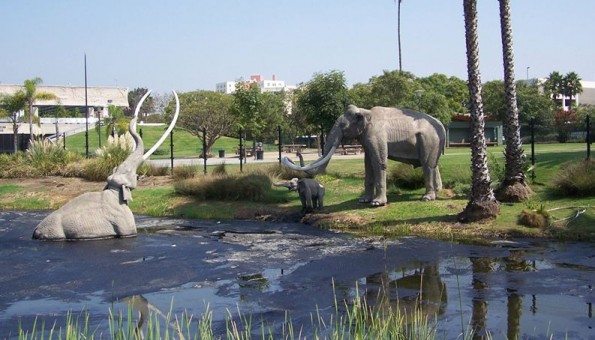
The Page Museum of Los Angeles offers life-size replicas of extinct mammals at the Rancho La Brea in Hancock Park. Although called the “tar pits,” the pools are asphalt.
The friar, Juan Crespi, was the first person to use the term “bitumen” in describing these sticky pools in southern California — where crude oil has been seeping from the ground through fissures in the coastal plain sediments for more than 40,000 years. Native Americans used the substance for centuries to waterproof baskets and caulk canoes.
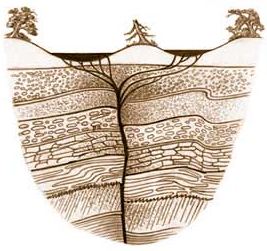
Sticky pools form when crude oil seeps to the surface through fissures in the earth’s crust.
Although popularly called the tar pits, the pools at Rancho La Brea are actually asphalt — not tar, which is a by-product made by the distillation of woody materials, such as peat. Asphalt is a naturally formed substance comprised of hydrocarbon molecules (see Asphalt Paves the Way).
Learn more in Discovering the Le Brea Tar Pits.

August 3, 1942 – War brings “Big Inch” and “Little Big Inch” Pipelines
War Emergency Pipelines Inc. began construction on the “Big Inch” line — the longest petroleum pipeline project ever undertaken in the United States. Conceived to supply wartime fuel demands — and in response to U-boat attacks on oil tankers along the eastern seaboard and Gulf of Mexico, the “Big Inch” and “Little Big Inch” lines were extolled as “the most amazing government-industry cooperation ever achieved.”
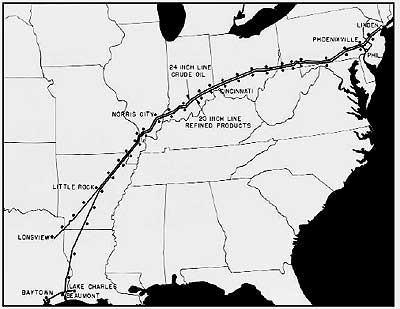
The longest petroleum pipeline project ever undertaken led to construction of a 24-inch pipeline from East Texas to Illinois, and a 20-inch line as far as New York City.
With a goal of transporting 300,000 barrels of oil per day, the $95 million project called for construction of a 24-inch pipeline (Big Inch) from East Texas to Illinois, and a 20-inch line (Little Big Inch) as far as New York and Philadelphia. The pipelines would reach more than 1,200 miles (the Trans-Alaska pipeline system is 800 miles long).
Learn more in Big Inch Pipelines of WWII.
_______________________
Recommended Reading: The Oil Scouts – Reminiscences of the Night Riders of the Hemlocks (1986); Trek of the Oil Finders: A History of Exploration for Petroleum (1975); Amazing Pipeline Stories: How Building the Trans-Alaska Pipeline Transformed Life in America’s Last Frontier
(1986); Trek of the Oil Finders: A History of Exploration for Petroleum (1975); Amazing Pipeline Stories: How Building the Trans-Alaska Pipeline Transformed Life in America’s Last Frontier (1997). Early Texas Oil: A Photographic History, 1866-1936
(1997). Early Texas Oil: A Photographic History, 1866-1936 (2000); Eisenhower: Soldier and President
(2000); Eisenhower: Soldier and President (1968); The Extraction State, A History of Natural Gas in America (2021); Torpedoes in the Gulf: Galveston and the U-Boats, 1942-1943
(1968); The Extraction State, A History of Natural Gas in America (2021); Torpedoes in the Gulf: Galveston and the U-Boats, 1942-1943 (1995). The Big Roads: The Untold Story of the Engineers, Visionaries, and Trailblazers Who Created the American Superhighways
(1995). The Big Roads: The Untold Story of the Engineers, Visionaries, and Trailblazers Who Created the American Superhighways (2012); Monsters Of Old Los Angeles – The Prehistoric Animals Of The La Brea Tar Pits
(2012); Monsters Of Old Los Angeles – The Prehistoric Animals Of The La Brea Tar Pits (2008); Oil: From Prospect to Pipeline
(2008); Oil: From Prospect to Pipeline (1971). Amazon purchases benefit the American Oil & Gas Historical Society. As an Amazon Associate, AOGHS earns a commission from qualifying purchases.
(1971). Amazon purchases benefit the American Oil & Gas Historical Society. As an Amazon Associate, AOGHS earns a commission from qualifying purchases.
_______________________
The American Oil & Gas Historical Society (AOGHS) preserves U.S. petroleum history. Please become an AOGHS annual supporter and help maintain this energy education website and expand historical research. For more information, contact bawells@aoghs.org. Copyright © 2025 Bruce A. Wells. All rights reserved.
by Bruce Wells | Jul 21, 2025 | This Week in Petroleum History
July 21, 1935 – “Diamond Glenn” McCarthy strikes Oil –
Glenn H. McCarthy struck oil 50 miles east of Houston in 1935, extending the already prolific Anahuac field. The well was the first of many for the Texas independent producer who would discover 11 Texas oilfields by 1945.
McCarthy became known as another “King of the Wildcatters” and “Diamond Glenn” by 1950, when his estimated worth reached $200 million ($2 billion today).
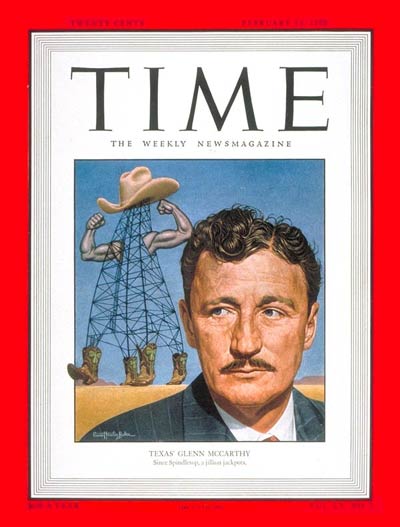
TIME magazine in 1950 featured Texas wildcatter Glenn McCarthy of Houston.
In addition to his McCarthy Oil and Gas Company, McCarthy eventually owned a gas company, a chemical company, a radio station, 14 newspapers, a magazine, two banks, and the Shell Building in Houston. In the late 1940s, he invested $21 million to build the 18-story, 1,100-room Shamrock Hotel — and reportedly spent $1 million on its St. Patrick’s Day 1949 opening gala, which newspapers dubbed “Houston’s biggest party.”
Learn more in “Diamond Glenn” McCarthy.
July 22, 1933 – Phillips Petroleum sponsors Flight around the World
Before 50,000 cheering New York City onlookers, former roughneck Wiley Post landed his Lockheed 5C Vega “Winnie Mae,” becoming the first person to fly solo around the world. Post had worked in oilfields near Walters, Oklahoma, when he took his first airplane ride with a barnstormer in 1919 and was inspired to take lessons.
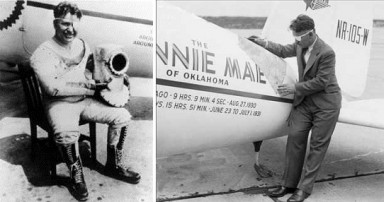
Thanks to a friendship with Frank Phillips, Wiley Post set altitude records and became the first person to fly solo around the world.
In 1926, on the first day of working at a well near Seminole, a metal splinter severely damaged his left eye, causing loss of sight. Post used the $1,700 in compensation to buy his first airplane. He became friends with Frank Phillips, president of Phillips Petroleum, sponsor of several high-altitude experimental flights. Phillips also sponsored the “Woolaroc” — winning plane of an August 1926 air race across the Pacific.

July 22, 1959 – Marker erected for Second U.S. Oil Well
The Pennsylvania Historical and Museum Commission dedicated a state marker to commemorate the man who drilled for oil just a few days after Edwin Drake completed the first U.S. commercial well on August 27, 1859. “After Drake’s discovery of oil in Titusville, some area residents attempted to sink their own well,” noted historians at Explore Pennsylvania. “The vast majority of such efforts failed.”
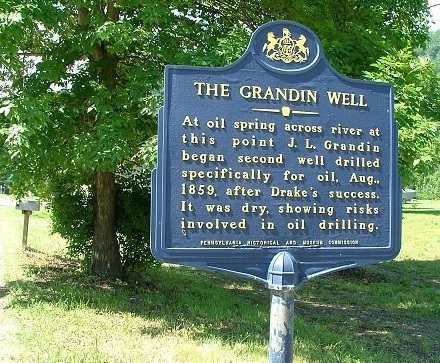
Pennsylvania historical marker for the 1859 Grandin well — America’s second oil well, which was a dry hole.
Using a simple spring pole, 22-year-old John Grandin and a local blacksmith began to “kick down” a well that would reach almost twice as deep as Drake’s cable-tool depth of 69.5 feet. Despite not finding the oil-producing formation (the Venango Sands), Grandin’s well produced several “firsts” for the young U.S. petroleum industry.
Learn more in First Dry Hole.
July 23, 1872 – “Real McCoy” Steam-Engine Lubricator
Using petroleum for improving the performance of locomotives became widespread when Elijah McCoy patented an automatic lubricator for steam engines. McCoy designed a device that applied oil through a drip cup to locomotive and ship steam engines. Instead of stopping engines to apply necessary lubrication, McCoy’s device provided it while they ran, saving railroads time and money.
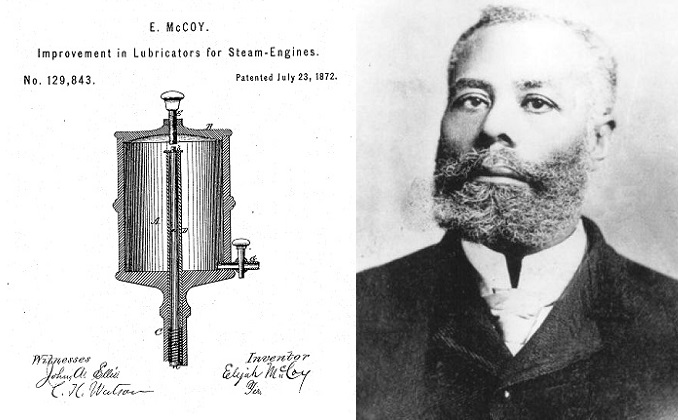
Elijah McCoy invented lubrication systems for steam engines, early beneficiaries of petroleum. Awarded more than 60 patents, he was inducted into the National Inventors Hall of Fame in 2001.
The Canadian-born McCoy was the son of slaves who had escaped Kentucky. After his family settled in Michigan, 15-year-old McCoy traveled to Scotland to study mechanical engineering. By the time he died in 1929, the inventor had received 60 patents, according to a 1994 Michigan historical marker.
The expression “the real McCoy” reportedly came from railroad engineers not wanting to buy low-quality copycats of his popular device. Before purchasing the lubricator, buyers would ask if it was “the real McCoy.”
July 23, 1951 – Desk & Derrick Clubs organize
After a secretary at Humble Oil and Refining Company organized the first club in New Orleans, the Association of Desk & Derrick Clubs (ADDC) of North America officially began with articles of association signed by the presidents of clubs in Jackson, Mississippi, New Orleans, Los Angeles, and Houston. By 1952, representatives from 40 clubs would attend the first ADDC convention, held at Houston’s Shamrock Hotel.
Learn more in Desk and Derrick Educators.

July 24, 2000 – BP unveils New Green and Yellow Logo
BP — the official name of a group of companies including Amoco, ARCO and Castrol — unveiled a new corporate identity brand, replacing the “Green Shield” logo with a green and yellow sunflower pattern.

The company also introduced a new corporate slogan: “Beyond Petroleum.” When BP — then British Petroleum — merged with Amoco in 1998, the company’s name briefly changed to BP Amoco before all stations converted to the BP brand.
July 25, 1543 – Oil reported in New World
The first documented report of oil in the New World resulted when a storm forced Spanish explorer Don Luis de Moscoso to land two of his brigantines at the mouth of the Sabine River. He had succeeded expedition leader Hernando de Soto and built seven of the small vessels to sail down the newly discovered Mississippi River and westward along the Gulf Coast.
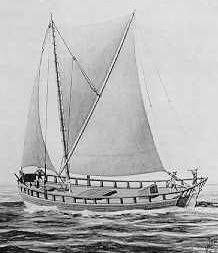
Spanish explorers used brigantines to sail along the Gulf Coast in 1543.
According to an account of the expedition, Indians knew of the future Texas’ natural seeps. “There was found a skumme, which they call Copee, which the Sea casteth up, and it is like Pitch, wherewith in some places, where Pitch is wanting, they pitch their ships; there they pitched their Brigandines.”
Learn more about the first reports of oil worldwide in Earliest Signs of Oil.
July 27, 1918 – Standard Oil of New York launches Concrete Tanker
America’s first concrete vessel designed to carry oil, the Socony, left its shipyard at Flushing Bay, New York. Built for the Standard Oil Company of New York, the barge was 98 feet long with a 32-foot beam and carried oil in six center and two wing compartments, “oil-proofed by a special process,” according to the journal Cement and Engineering News.

Socony, the first concrete oil tanker, launched in 1918. Below is a second version of the oil barge.
“Eight-inch cast iron pipe lines lead to each compartment and the oil pump is located on a concrete pump room aft,” the journal explained. Steel shortages during World War II would lead to the construction of larger reinforced concrete oil tankers.
_______________________
Recommended Reading: The Big Rich: The Rise and Fall of the Greatest Texas Oil Fortunes (2009); From Oklahoma to Eternity: The Life of Wiley Post and the Winnie Mae
(2009); From Oklahoma to Eternity: The Life of Wiley Post and the Winnie Mae (1998); Myth, Legend, Reality: Edwin Laurentine Drake and the Early Oil Industry
(1998); Myth, Legend, Reality: Edwin Laurentine Drake and the Early Oil Industry (2009); Western Pennsylvania’s Oil Heritage
(2009); Western Pennsylvania’s Oil Heritage (2008); Trek of the Oil Finders: A History of Exploration for Petroleum (1975); Anomalies, Pioneering Women in Petroleum Geology, 1917-2017; Breaking the Gas Ceiling: Women in the Offshore Oil and Gas Industry (2019). Your Amazon purchase benefits the American Oil & Gas Historical Society. As an Amazon Associate, AOGHS earns a commission from qualifying purchases.
(2008); Trek of the Oil Finders: A History of Exploration for Petroleum (1975); Anomalies, Pioneering Women in Petroleum Geology, 1917-2017; Breaking the Gas Ceiling: Women in the Offshore Oil and Gas Industry (2019). Your Amazon purchase benefits the American Oil & Gas Historical Society. As an Amazon Associate, AOGHS earns a commission from qualifying purchases.
_______________________
The American Oil & Gas Historical Society (AOGHS) preserves U.S. petroleum history. Please become an AOGHS annual supporter and help maintain this energy education website and expand historical research. For more information, contact bawells@aoghs.org. © 2025 Bruce A. Wells. All rights reserved.
by Bruce Wells | Jul 14, 2025 | This Week in Petroleum History
July 14, 1863 – Patent issued for “Tool for Boring Rock” –
French tunnel engineer Rodolphe Leschot received a U.S. patent for a “Tool for Boring Rock.” His concept included a ring of industrial-grade diamonds on the end of a tubular drill rod designed to cut a cylindrical core. Water pumped through the drill rod, washed away cuttings and cooled the bit. Leschot’s system proved successful in drilling blast holes for tunneling.
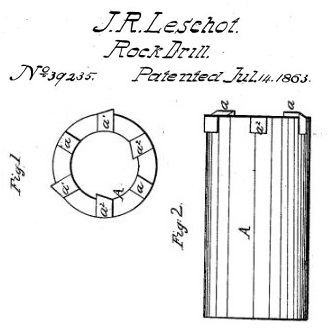
French engineer Rodolphe Leschot’s cutting-edge 1863 drilling technology.
At the same time, the use of diamond bits in oil well drilling was being examined in the petroleum regions of western Pennsylvania. It is not known if there is any connection between the 1865 experimental diamond core drilling in Pennsylvania and the Leschot blast hole drilling in France.
July 14, 1891 – Rockefeller expands Tank Car Empire
John D. Rockefeller incorporated the Union Tank Line Company in New Jersey and transferred his fleet of several thousand oil tank cars to the Standard Oil Trust. He then systematically acquired control of all but 200 of America’s 3,200 tank cars. By 1904, the rolling fleet had grown to 10,000.
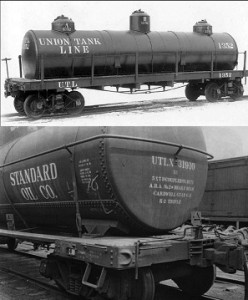
Standard Oil established the Union Tank Line Company to exclusively ship its petroleum.
Union Tank Line Company shipped only Standard Oil products until 1911, when the U.S. Supreme Court mandated the dissolution of Standard Oil. The new shipping company changed its name to Union Tank Car Company (keeping Standard Oil’s UTL or UTLX markings seen today). The company introduced a 50,000-gallon tank car in 1963, the largest in rail service at the time.
July 16, 1907 – Drilling Pioneer patents Casing Shoe
After drilling wells in Kern River oilfields, R. Carlton “Carl” Baker (1872-1957) of Coalinga, California, patented the Baker well-casing shoe. His cable-tool innovation at the bottom of the casing string increased efficiency and reliability for ensuring oil flowed through a well.
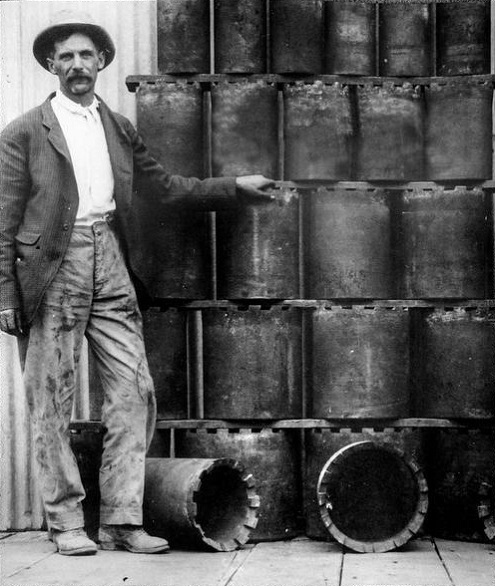
Reuben Carlton “Carl” Baker standing next to Baker Casing Shoes in 1914. Photo courtesy R.C. Baker Memorial Museum.
Baker, who in 1903 founded the Coalinga Oil Company, by 1913 had established the Baker Casing Shoe Company (renamed Baker Tools two years later). The inventor opened his first manufacturing plant in Coalinga before moving headquarters to Los Angeles in the 1930s. The company became Baker International in 1976 and Baker Hughes after a 1987 merger with Hughes Tool Company.
Learn more in Carl Baker and Howard Hughes.
July 16, 1926 – Oil Discovery launches Seminole Drilling Boom
Three years after an oil well was completed near Bowlegs, Oklahoma, a gusher south of Seminole revealed the true oil potential of Seminole County. The Fixico No. 1 well penetrated the prolific Wilcox Sands formation at a depth of 4,073 feet.
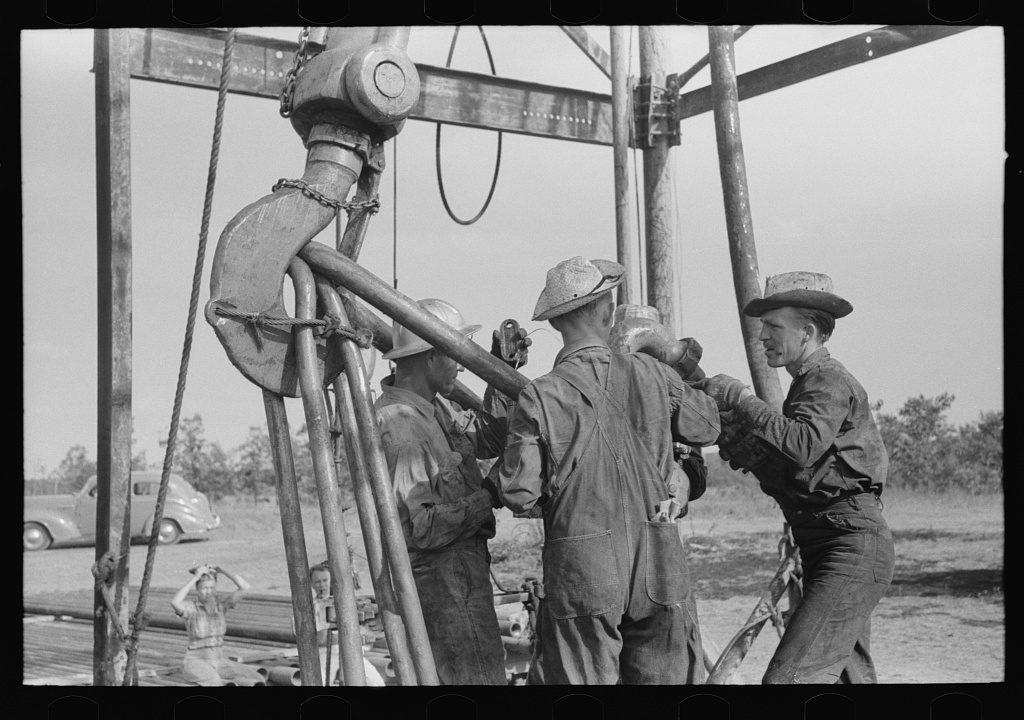
“Oil workers working on lowered traveling block” at well in Seminole oilfield, August 1939. Photo by Russell Lee (1903-1986) courtesy Library of Congress.

Drilled by R.F. Garland and his Independent Oil Company, the well was among more than 50 Greater Seminole Area oil reservoirs discovered; six were giants that produced more than one million barrels of oil each. With the Oklahoma City oilfield added in 1928, Oklahoma became the largest supplier of oil in the world by 1935.
Learn more in Seminole Oil Boom.

July 16, 1935 – Oklahoma Oil Boom brings First Parking Meter
As the booming Oklahoma City oilfield added to the congestion of cars downtown, the world’s first parking meter was installed at the corner of First Street and Robinson Avenue. Carl C. Magee, publisher of the Oklahoma News, designed the Park-O-Meter No. 1, today preserved by the Oklahoma Historical Society.
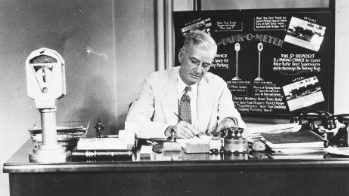
Oklahoma college students helped Carl Magee design the Park-O-Meter No. 1. Photo courtesy Oklahoma Historical Society.
“The meter charged five cents for one hour of parking, and naturally citizens hated it, viewing it as a tax for owning a car,” noted historian Josh Miller in 2012. “But retailers loved the meter, as it encouraged a quick turnover of customers.”
Park-O-Meters were manufactured by the MacNick Company of Tulsa, maker of timing devices used to detonate nitroglycerin in wells — and an oilfield services competitor of Zebco, the Zero Hour Bomb Company.
July 16, 1969 – Kerosene fuels launch of Saturn V Moon Rocket
A 19th-century petroleum product made America’s 1969 moon landing possible. Kerosene powered the first-stage rocket engines of the Saturn V when it launched the Apollo 11 mission on July 16. Four days later, astronaut Neil Armstrong announced, “Houston, Tranquility Base here. The Eagle has landed.”
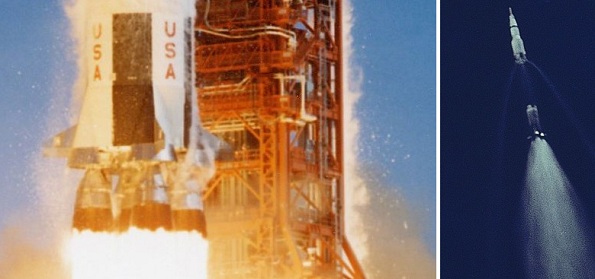
Powered by five first-stage engines fueled by “rocket grade” kerosene, the Saturn V was the tallest, heaviest and most powerful rocket ever built until the SpaceX Starship. Photos courtesy NASA.
Five engines of the Saturn V’s first stage burned “Rocket Grade Kerosene Propellant” at 2,230 gallons per second, generating almost eight million pounds of thrust. The fuel was a highly refined kerosene RP-1 (Rocket Propellant-1) that began as “coal oil” for lamps.
When Canadian Abraham Gesner (1797-1864) first refined the lamp fuel from coal in 1846, he coined the term kerosene from the Greek word keros (wax), but many people called it “coal oil.” A highly refined version of his product now fuels rockets, including the SpaceX Falcon 9.
Learn more in Kerosene Rocket Fuel.
July 18, 1929 – Darst Creek Oilfield discovered in West Texas
With initial production of 1,000 barrels of oil a day, the Texas Company No. 1 Dallas Wilson well revealed a new West Texas oilfield at Darst Creek in Guadalupe County, about five miles from the southwestern edge of the Luling oilfield. The field would be developed by Humble Oil and Refining (later Exxon), Gulf Production Company, Magnolia Petroleum (later Mobil), as well as the Texas Company (later Texaco).
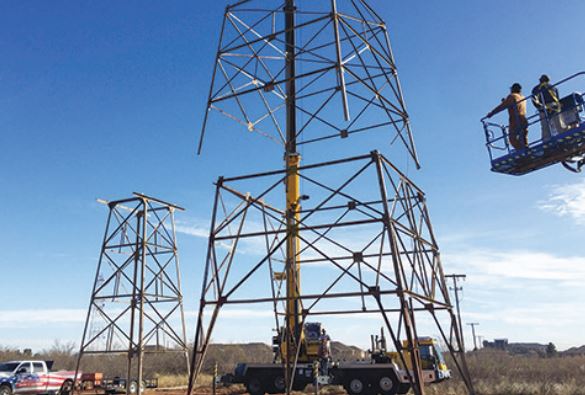
The Petroleum Museum of Midland, Texas, erected in 2019 a circa 1930 derrick used in the Darst Creek oilfield. Photo courtesy the Petroleum Museum.
By December 1931, the Darst Creek field produced more than 19.7 million barrels of oil from an average depth of 2,650 feet, according to a Humble Oil geologist, who noted that of the 291 wells drilled, just 19 were dry holes. The West Texas field was also among the first to operate under proration.
“To avoid the risks of unregulated production with a resulting loss of reservoir pressure, water encroachment and cheap crude prices, the operators agreed to voluntary proration in the field,” noted the Petroleum Museum, adding that “voluntary proration proved to be difficult to maintain.” The Midland museum celebrates its 50th year of preserving Permian Basin history this September.

July 19, 1915 – Petroleum powers Washers and Mowers
Howard Snyder applied to patent his internal combustion-powered washing machine, assigning the rights to the Maytag Company. His washer for “the ordinary farmer” who lacked access to electricity used a one-cylinder, two-cycle engine that could operate using gasoline, kerosene, or alcohol.
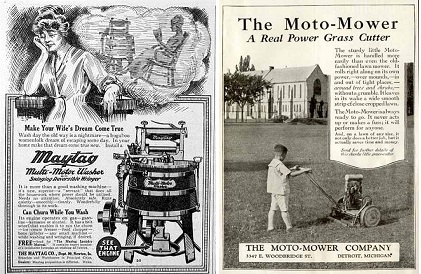
Advertisements featured two popular consumer products powered by air-cooled internal combustion engines.
Four years later, Edwin George of Detroit removed the engine from his wife’s Maytag washing machine and added it to a reel-type lawnmower. His invention launched the Moto-Mower Company, which sold America’s first commercially successful gasoline-powered lawn mower.
July 19, 1957 – Oilfield discovered in Alaska Territory
Although some oil production had occurred earlier in the territory, Alaska’s first commercial oilfield was discovered by Richfield Oil Company, which completed its Swanson River Unit No. 1 in Cook Inlet Basin. The well yielded 900 barrels of oil per day from a depth of 11,215 feet.
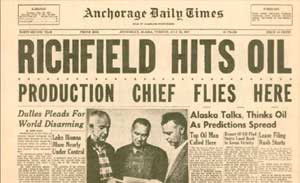
Even the Anchorage Daily Times could not predict oil production would account for more than 90 percent of Alaska’s revenue.
Alaska’s first governor, William Egan, proclaimed the oilfield discovery provided “the economic justification for statehood for Alaska” in 1959. Richfield leased more than 71,000 acres of the Kenai National Moose Range, now part of the 1.92 million-acre Kenai National Wildlife Refuge.
By June 1962, about 50 wells were producing more than 20,000 barrels of oil a day. Richfield Oil Company merged with Atlantic Refining Company in 1966, becoming Atlantic Richfield (ARCO), which with Exxon discovered the giant Prudhoe Bay field in 1968.
Learn more in First Alaska Oil Wells.
July 20, 1920 – Discovery Well of the Permian Basin
The Permian Basin made headlines in 1920 when a wildcat well erupted oil from a depth of 2,750 feet on land owned by Texas Pacific Land Trust agent William H. Abrams, who just weeks earlier had discovered the West Columbia oilfield in Brazoria County south of Houston.
The latest W.H. Abrams No. 1 well — “shot” with nitroglycerin by the Texas Company (later Texaco) — proved to be part of the Permian Basin, encompassing 75,000 square miles in West Texas and southeastern New Mexico.
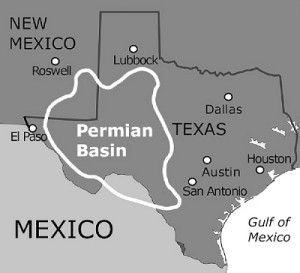
The Permian Basin would become the leading source of U.S. oil. Image courtesy Rigzone.
According to a Mitchell County historical marker, “land that sold for 10 cents an acre in 1840 and $5 an acre in 1888 now brought $96,000 an acre for mineral rights, irrespective of surface values…the flow of oil money led to better schools, roads and general social conditions.”
In 1923, the Santa Rita No. 1 discovery well near Big Lake brought yet another Texas drilling boom — and helped establish the University of Texas.

July 20, 2006 – Hughes Glomar Explorer recognized as Engineering Landmark
Former top-secret CIA ship Hughes Glomar Explorer, which became a pioneering petroleum industry drillship, was designated a mechanical engineering landmark during a Houston awards ceremony that included members of the original engineering team and the ship’s crew.
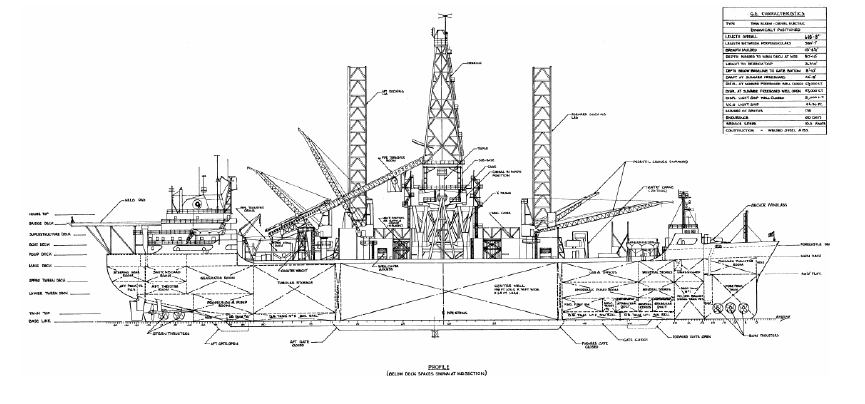
The American Society of Mechanical Engineers (ASME) in 2006 proclaimed Hughes Glomar Explorer, “a technologically remarkable ship.” Illustration courtesy ASME.
The American Society of Mechanical Engineers (ASME) designated the vessel, a technologically remarkable ship and historic mechanical engineering landmark. Built in 1972 as a clandestine Soviet submarine recovery project, the vessel’s design was “decades ahead of its time for working at extreme depths.” Modified and relaunched in 1998, the highly advanced Glomar Explorer became a pioneer of modern drillships.
_______________________
Recommended Reading: History Of Oil Well Drilling (2007); Drilling Technology in Nontechnical Language
(2007); Drilling Technology in Nontechnical Language (2012); The American Railroad Freight Car (1995); Early Days of Oil: A Pictorial History of the Beginnings of the Industry in Pennsylvania
(2012); The American Railroad Freight Car (1995); Early Days of Oil: A Pictorial History of the Beginnings of the Industry in Pennsylvania (2000); Western Pennsylvania’s Oil Heritage
(2000); Western Pennsylvania’s Oil Heritage (2008); Stages to Saturn: A Technological History of the Apollo/Saturn Launch Vehicles
(2008); Stages to Saturn: A Technological History of the Apollo/Saturn Launch Vehicles (2003); Wildcatters: Texas Independent Oilmen
(2003); Wildcatters: Texas Independent Oilmen (1984); From the Rio Grande to the Arctic: The Story of the Richfield Oil Corporation
(1984); From the Rio Grande to the Arctic: The Story of the Richfield Oil Corporation (1972); Kenai Peninsula Borough, Alaska
(1972); Kenai Peninsula Borough, Alaska (2012); Texon: Legacy of an Oil Town, Images of America
(2012); Texon: Legacy of an Oil Town, Images of America (2011); Oil in West Texas and New Mexico
(2011); Oil in West Texas and New Mexico (1982); The CIA’s Greatest Covert Operation: Inside the Daring Mission to Recover a Nuclear-Armed Soviet Sub (2012); Project Azorian: The CIA and the Raising of the K-129 (2012). Your Amazon purchase benefits the American Oil & Gas Historical Society. As an Amazon Associate, AOGHS earns a commission from qualifying purchases.
(1982); The CIA’s Greatest Covert Operation: Inside the Daring Mission to Recover a Nuclear-Armed Soviet Sub (2012); Project Azorian: The CIA and the Raising of the K-129 (2012). Your Amazon purchase benefits the American Oil & Gas Historical Society. As an Amazon Associate, AOGHS earns a commission from qualifying purchases.
_______________________
The American Oil & Gas Historical Society (AOGHS) preserves U.S. petroleum history. Please become an AOGHS annual supporter and help maintain this energy education website and expand historical research. For more information, contact bawells@aoghs.org. © 2025 Bruce A. Wells. All rights reserved.








(1994); Bird’s Eye Views: Historic Lithographs of North American Cities
(1998); Bertha Takes a Drive: How the Benz Automobile Changed the World
(2017); Western Pennsylvania’s Oil Heritage
(2008); Winners’ Viewpoints: The Great 1927 Trans-Pacific Dole Race
(2009); Groundbreakers: The Story of Oilfield Technology and the People Who Made it Happen (2015); Sign of the 76: The fabulous life and times of the Union Oil Company of California
(1977); Trek of the Oil Finders: A History of Exploration for Petroleum (1975); Unleaded: How Changing Our Gasoline Changed Everything (2021). Your Amazon purchase benefits the American Oil & Gas Historical Society. As an Amazon Associate, AOGHS earns a commission from qualifying purchases.







































